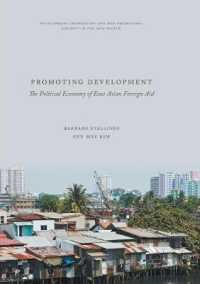- ホーム
- > 洋書
- > 英文書
- > Science / Mathematics
Full Description
The book provides a comprehensive overview of the various geological provinces in Ghana, with a major emphasis on the gold mineralization styles. Specifically, it elucidates the geology of Ghana in the context of gold deposits.
Ghana is located in the Leo-Man Shield of the West African Craton (WAC), enriched in several precious mineral deposits, especially gold, and hence was once called "Gold Coast" before independence in 1957. Today, Ghana is the largest gold producer in Africa and the sixth largest globally. Gold production in the country constitutes about one-third of the country's total revenue. Gold deposits in Ghana have been exploited for centuries. However, except for a few isolated and, probably, old literature, knowledge gaps towards understanding gold mineralization styles in Ghana are evident. Also, studies related to the genesis of the major types of gold mineralization in Ghana are inadequate. Therefore, this book mainly focuses on comprehensively describing the geology of Ghana and establishing the link between the geology and gold mineralization. The contributions involve current state-of-the-art knowledge of gold deposits based on field studies, petrology, structural geology, geodynamic settings/tectonics, geochemistry, isotope geology, economic geology, and related studies.
The book is divided into five parts, covering all the aspects of the geology and gold mineralization in Ghana. The first part introduces readers to the geology and gold mineralization styles in Ghana and provides a brief description of the occurrence and general geological features of the main gold deposit types in Ghana. The second part features the structural controls on gold deposits in Ghana since gold mineralization in the country is primarily structurally controlled. Moreover, since the gold deposits in Ghana are largely hosted in lithologies belonging to the Birimian Supergroup and the Tarkwaian Group, the petrogenesis of these lithologies is discussed in the third part. In the fourth part, the geology, mineralogy, geochemistry, fluid evolution, and genesis of hydrothermal gold deposits in Ghana are discussed. Finally, in the last part, readers will find the application of new techniques like machine learning in predicting gold-bearing lithologies in Ghana.
The book would provide a conceptual framework for identifying gaps in future research on gold mineralization in the country. The book will be helpful to students/researchers/faculty members studying Earth Science-related programs and also assist industries in understanding the various rock types in Ghana and the general styles of gold mineralization. It can be used as a textbook at higher levels of education in the country and globally.
Contents
.- Part I: Introduction to the Geology and Gold Mineralization in Ghana1-Geology and Gold Mineralization Styles in Ghana
.- Part II: Structural Controls of Gold Deposits in Ghana 2- Structural Controls on Orogenic Gold Mineralization: Evidence from the Major Operating Mines in Ghana
.- Part III: Geology, Mineralogy, Geochemistry, Fluid Evolution and Genesis of Hydrothermal Gold Deposits in Ghana3-Ore Petrography, Litho-characterization and Role of Host Rocks for Hydrothermal Gold Mineralization in the Subika Deposit, Ahafo, Ghana4-Constraints on Fluid Composition and Physico-chemical Conditions for the Birimian Gold Deposits in Ghana5- Footprints of Hydrothermal Gold Mineralization in the Kawere Sandstones, Tarkwaian Group, Ghana: Insights from the Badukrom Prospect at Iduapriem6-Trace Element Characteristics in Ore-associated Sulfides and their Records of Fluid Conditions During Hydrothermal Gold Mineralization in the Damang Gold Deposit, SW Ghana7-A Comparative Study of the Rhyacian-Hosted Gold Deposits in Ghana and Mali: Implications for Gold Exploration in the Sub-Region
.- Part IV: Lithostratigraphy and Sedimentological Characteristics of the Voltaian Basin in Ghana8-An Overview of the Voltaian Basin of Ghana: A Guide for its Future Hydrocarbon Prospects Assessment.






